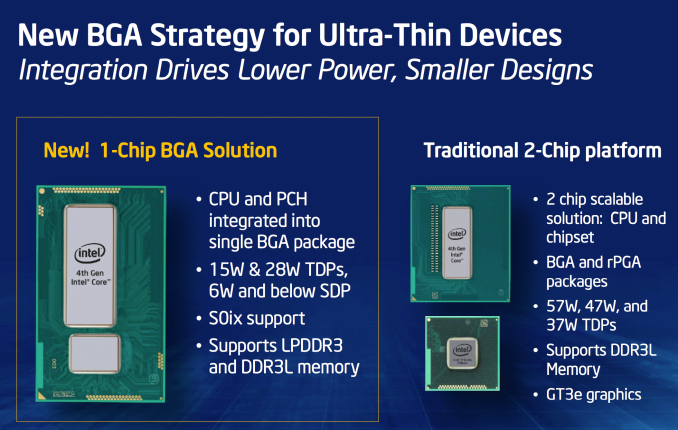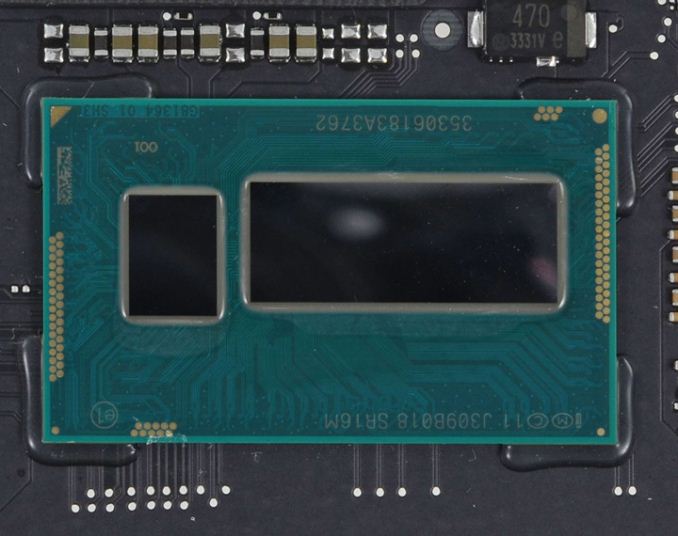The 2013 MacBook Air Review (13-inch)
by Anand Lal Shimpi on June 24, 2013 12:01 AM ESTThe CPUs
Apple keeps things simple across the 2013 MacBook Air lineup by configuring both 11 and 13-inch models with the same base CPU: a Core i5-4250U.
To understand Apple’s CPU choice, you have to understand that Apple is primarily concerned about improving battery life this generation. The line between MacBook Air and MacBook Pro has to be well defined. The Air is about portability, while the Pro is about performance. When faced with a power/performance tradeoff, it’s clear on which side of the fence Apple will fall whenever the MacBook Air is concerned.
| Apple 2013 MacBook Air CPU Comparison | |||||
| 1.3GHz dual-core | 1.7GHz dual-core | ||||
| Standard On | 11 & 13-inch MBA | Optional on Both | |||
| Intel Model | Core i5-4250U | Core i7-4650U | |||
| Base Clock Speed | 1.3GHz | 1.7GHz | |||
| Max SC Turbo | 2.6GHz | 3.3GHz | |||
| Max DC Turbo | 2.3GHz | 2.9GHz | |||
| L3 Cache | 3MB | 4MB | |||
| TSX-NI | No | Yes | |||
| TXT | No | Yes | |||
| AES-NI | Yes | Yes | |||
| VT-x/VT-x EPT | Yes | Yes | |||
| VT-d | Yes | Yes | |||
| TDP | 15W | 15W | |||
| Processor Graphics | Intel HD 5000 | Intel HD 5000 | |||
| GPU Clock (Base/Max) | 200/1000MHz | 200/1100MHz | |||
The lower base clock alone shouldn’t mean much, but the max TDP of the CPUs in the new MacBook Air falls as well - from 17W down to 15W. The thermal limit is even more dramatic since with Haswell ULT, the 15W includes the CPU/GPU as well as the on-package PCH. In Ivy Bridge the PCH was off package and wasn’t included in the 17W TDP.
Max turbo clocks are identical between the Haswell ULT CPUs Apple picked this round and the Ivy Bridge models before, but with a lower TDP it’ll be harder to always sustain the same frequencies given the right workload.
Haswell does feature a not insignificant gain in IPC compared to Ivy Bridge, which should help offset the power constraints that could otherwise force a larger regression in performance.
Both 2013 MBAs ship with the same CPU by default, and both can be upgraded to the same higher end SKU: a Core i7-4650U. The 4650U retains the same 15W TDP as the i5-4250U, but it increases its base clock speed to 1.7GHz and max turbo to 3.3GHz. The L3 cache also grows from 3MB to 4MB. All in all, this should be a very healthy upgrade in performance. Intel likely maintains the same TDP by binning for power; the i7-4650U is probably capable of running at higher frequencies without any appreciable increase in voltage. The max GPU clock also goes up by 10%.
Haswell ULT, Courtesy iFixit
What's arguably coolest about the i7-4650U is it enables Haswell's Transactional Synchronization Extensions (TSX-NI), a feature which is unfortunately disabled on the i5-4250U. I don't suspect this will matter much for most MBA users, but anyone looking to play around with Haswell's TSX instructions will want to opt for the higher end SKU. The upgrade costs $150 regardless of base model. Intel charges $454 for the i7-4650U and $342 for the i5-4250U, a difference of $112; Apple is adding another $38 onto the 1KU pricing, which isn't unreasonable.
Many have asked me what the impact of the i7 will be on battery life. I'm hoping to get my hands on an i7 based machine when I return from the UK in a week, but for those of you making immediate decisions I'll offer the following. Sustained operation at higher frequencies will likely draw more power, and negatively impact battery life. Light to medium workloads will enjoy a mix of race to sleep benefits as well as higher power consumption under load. Idle power should be roughly similar between the parts however. For most workloads I'd expect a modest impact to battery life, but it won't be enough to regress to 2012 levels of battery life. All of this is said without knowing key details like operating voltage for most 4650Us. I plan on addressing that shortly.












233 Comments
View All Comments
malcolmcraft - Thursday, October 9, 2014 - link
MacBook Air is absolutely fantastic! It is also interesting that it's the highest rated laptop among consumers (see http://www.consumertop.com/best-laptop-guide/)... I would not trade mine for anything.darwinosx - Monday, July 8, 2013 - link
If you read the review you are commenting on you would know its not a terrible display.Subyman - Monday, June 24, 2013 - link
Did you even read Anand's article? He explains why.sigmatau - Monday, June 24, 2013 - link
Yes, apparently it is good to have a long battery life so you can be able to stare at a horrible display for as long as possible. I'd rather have that display in a $400 laptop. Actually, not even at that price point.designerfx - Monday, June 24, 2013 - link
exactly. I laugh when people look at GPU performance when they forget that it's at 1366x768. You can get better (and AMD does) in IGP.josef195 - Tuesday, August 20, 2013 - link
I laugh when people complain about good GPU performance at 1366x768 when it's actually 1440x900jmmx - Monday, June 24, 2013 - link
hardly a horrible display! Have you ever seen one? Not only are they very fine - though admittedly not as high resolution as others, but according to one monitor expert - only Apple displays have a consistency and an out-of-the-box color setting that is very close to professionally calibrated.sigmatau - Tuesday, June 25, 2013 - link
OK, I will say that Apple offers some of the best displays, but the best 1366x768 display is still terrible even on a 13" display. Not sure why Apple didn't go with a 1080p display with haswell since any increase battery waste from the display should be more than mitigated by the increased efficiency of the CPU/GPU. It's not like anyone does any serious gaming on these laptops so a higher resolution display will not be affected there either.KitsuneKnight - Tuesday, June 25, 2013 - link
The display is 1440x900 on the 13", not 1366x768 (that's the 11"). It's also one of the damn nicest displays I've ever had the pleasure of using (even the viewing angles doesn't bother me, maybe because it's the only laptop I've used with a decent henge).Personally, I'd opt for a 12 hour battery life over a retina-class display. Ideally, I'd have both, but it'll be quite a while before that becomes a possibility in any machine like the Air.
ThreeDee912 - Monday, June 24, 2013 - link
I'm not sure if it's the same panel, but the 2010 and 2011 reviews tested the LCD, and the panels had some of the best contrast ratios and black/white levels out of any TN panels at the time. It's no IPS, but they're still pretty darn good compared to everything else. While it would be nice if Apple made the panels IPS, I think the current panel resolution is fine.http://www.anandtech.com/show/3991/apples-2010-mac...
http://www.anandtech.com/show/4528/the-2011-macboo...
Also, I'm not sure why some people want to run an unscaled UI on super high-res panels, especially on laptops of this size. Yes, some smartphones have higher resolutions screens, but they scale things up so it's easier to read. Just stuffing in a high-res panel for the heck of it isn't the way to do things.